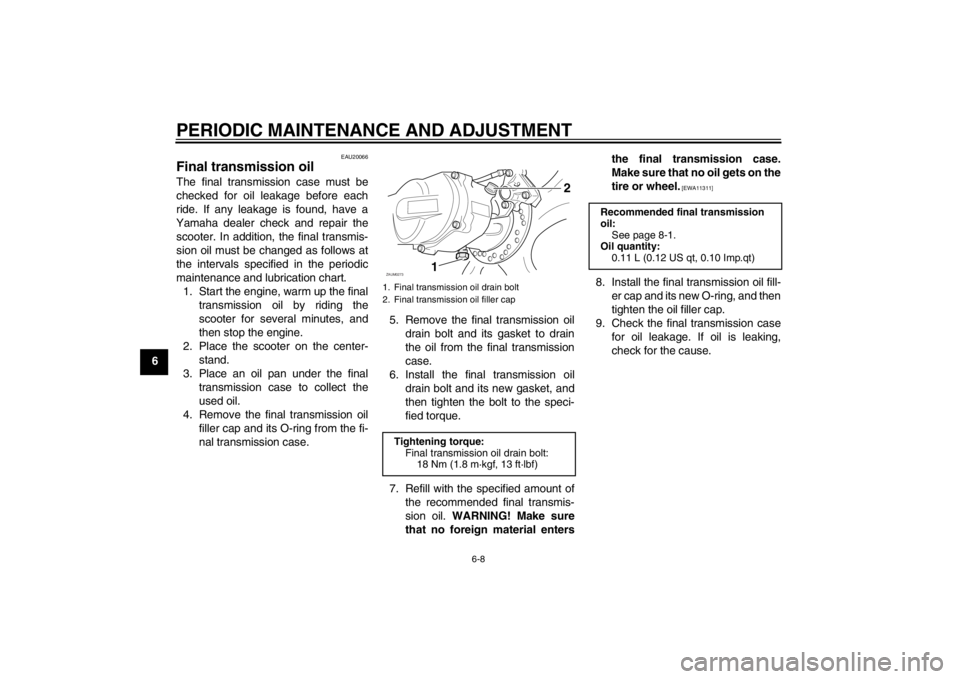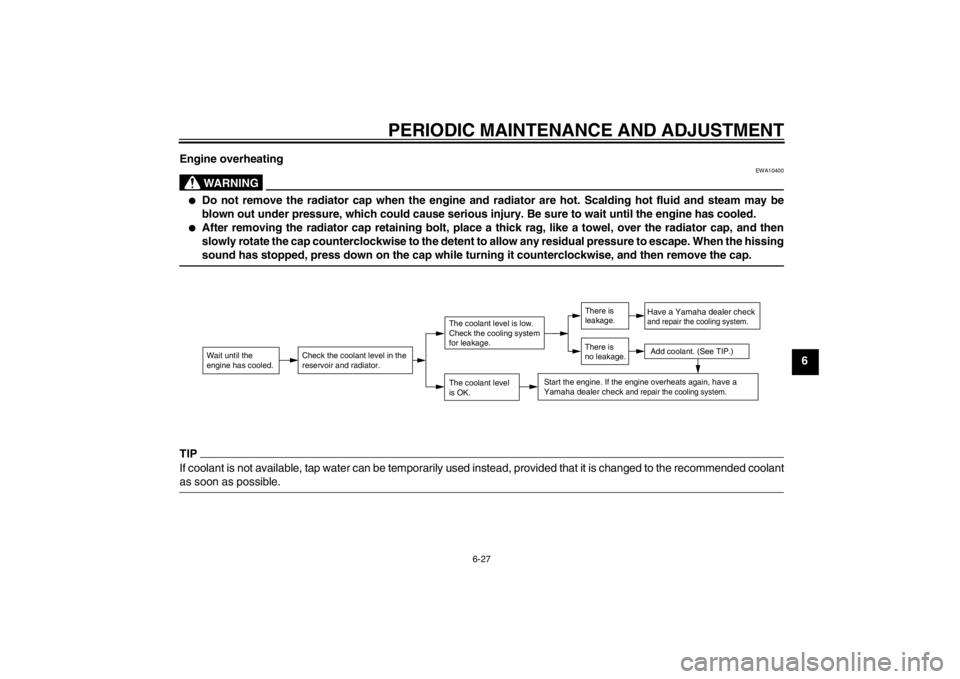Page 20 of 74

INSTRUMENT AND CONTROL FUNCTIONS
3-4
3
EAUM2821
Multi-function display (NS50)TIPThe multi-function display performs the
following self-test for three seconds in
order to check the electrical circuit.●
The speedometer digits display
from 0 to 80, and then from 80 to 0
in kilometers. If the speedometer is
set to miles, the digits will display
from 0 to 50, and then from 50 to 0.
●
All LCD segments and warning
lights come on and then go off.
WARNING
EWA12312
Be sure to stop the vehicle before
making any setting changes to the
multi-function display. Changing
settings while riding can distract the
operator and increase the risk of an
accident.The multi-function display is equipped
with the following:●
a digital clock
●
a digital speedometer (which
shows riding speed)
●
an odometer (which shows the to-
tal distance traveled)
●
a tripmeter (which shows the dis-
tance traveled since it was last set
to zero)
●
a fuel reserve tripmeter (which
shows the distance traveled on the
fuel reserve)
●
a fuel gauge
●
a self-diagnosis device
TIP●
Be sure to turn the key to “ ” be-
fore using the “RESET/SELECT”
button.
●
For the U.K. only: To switch the
speedometer and odometer/trip-
meter displays between kilometers
and miles, when the main switch is
turned to “ ”, press the “RE-
SET/SELECT” button for at least
eight seconds.
To set the clock:1. Select the odometer and push the
“RESET/SELECT” button for at
least three seconds.
2. When the hour digits start flashing,
push the “RESET/SELECT” button
to set the hours.
3. To change the minutes digits, push
the “RESET/SELECT” button for
at least three seconds.
1. Speedometer
2. Clock
3. “RESET/SELECT” button
4. Odometer/tripmeters/fuel reserve tripmeter
5. Fuel gaugeZAUM0911
1
2
34
5
ZAUM0912
U1PHE0E0.book Page 4 Wednesday, August 29, 2012 4:42 PM
Page 44 of 74

PERIODIC MAINTENANCE AND ADJUSTMENT
6-8
6
EAU20066
Final transmission oil The final transmission case must be
checked for oil leakage before each
ride. If any leakage is found, have a
Yamaha dealer check and repair the
scooter. In addition, the final transmis-
sion oil must be changed as follows at
the intervals specified in the periodic
maintenance and lubrication chart.
1. Start the engine, warm up the final
transmission oil by riding the
scooter for several minutes, and
then stop the engine.
2. Place the scooter on the center-
stand.
3. Place an oil pan under the final
transmission case to collect the
used oil.
4. Remove the final transmission oil
filler cap and its O-ring from the fi-
nal transmission case.5. Remove the final transmission oil
drain bolt and its gasket to drain
the oil from the final transmission
case.
6. Install the final transmission oil
drain bolt and its new gasket, and
then tighten the bolt to the speci-
fied torque.
7. Refill with the specified amount of
the recommended final transmis-
sion oil. WARNING! Make sure
that no foreign material entersthe final transmission case.
Make sure that no oil gets on the
tire or wheel.
[EWA11311]
8. Install the final transmission oil fill-
er cap and its new O-ring, and then
tighten the oil filler cap.
9. Check the final transmission case
for oil leakage. If oil is leaking,
check for the cause.
1. Final transmission oil drain bolt
2. Final transmission oil filler capTightening torque:
Final transmission oil drain bolt:
18 Nm (1.8 m·kgf, 13 ft·lbf)
12
ZAUM0273
Recommended final transmission
oil:
See page 8-1.
Oil quantity:
0.11 L (0.12 US qt, 0.10 Imp.qt)
U1PHE0E0.book Page 8 Wednesday, August 29, 2012 4:42 PM
Page 63 of 74

PERIODIC MAINTENANCE AND ADJUSTMENT
6-27
6 Engine overheating
WARNING
EWA10400
●
Do not remove the radiator cap when the engine and radiator are hot. Scalding hot fluid and steam may be
blown out under pressure, which could cause serious injury. Be sure to wait until the engine has cooled.
●
After removing the radiator cap retaining bolt, place a thick rag, like a towel, over the radiator cap, and then
slowly rotate the cap counterclockwise to the detent to allow any residual pressure to escape. When the hissing
sound has stopped, press down on the cap while turning it counterclockwise, and then remove the cap.
TIPIf coolant is not available, tap water can be temporarily used instead, provided that it is changed to the recommended coolant
as soon as possible.
Wait until the
engine has cooled.
Check the coolant level in the
reservoir and radiator.
The coolant level
is OK.The coolant level is low.
Check the cooling system
for leakage.
Have a Yamaha dealer checkand repair the cooling system.Add coolant. (See TIP.)
Start the engine. If the engine overheats again,
have a
Yamaha dealer check
and repair the cooling system.
There is
leakage.
There is
no leakage.
U1PHE0E0.book Page 27 Wednesday, August 29, 2012 4:42 PM